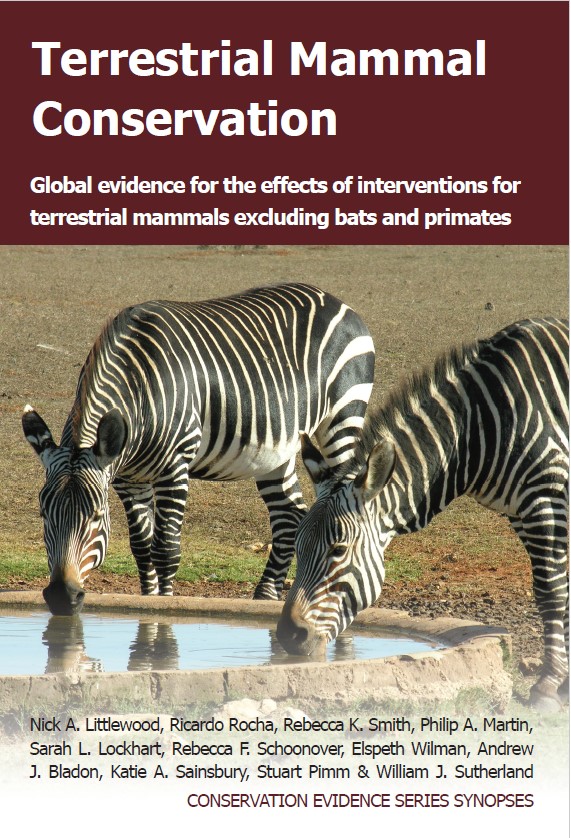Actions to conserve biodiversity
We have summarised evidence from the scientific literature about the effects of actions to conserve wildlife and ecosystems.
Review the evidence from the studies
Not sure what Actions are? Read a brief description.
Search for evidence
e.g. "frogs chytrid"
294 Actions found
Refine
Hide
294 Actions found
Download Actions
| 0 selected |
|
Order results by:
| Action | Effectiveness | Studies | Category | |
|---|---|---|---|---|
|
Eliminate highly virulent diseases early in an epidemic by culling all individuals (healthy and infected) in a defined area Action Link |
No evidence found (no assessment) | 0 |
|
|
|
Cull disease-infected animals Action Link |
Likely to be beneficial | 1 |
|
|
|
Use drugs to treat parasites Action Link |
Likely to be beneficial | 7 |
|
|
|
Establish populations isolated from disease Action Link |
Unknown effectiveness (limited evidence) | 1 |
|
|
|
Control ticks/fleas/lice in wild mammal populations Action Link |
Unknown effectiveness (limited evidence) | 2 |
|
|
|
Install barrier fencing along railways Action Link |
Unknown effectiveness (limited evidence) | 1 |
|
|
|
Install wildlife warning reflectors along roads Action Link |
Likely to be beneficial | 15 |
|
|
|
Install acoustic wildlife warnings along roads Action Link |
Unknown effectiveness (limited evidence) | 2 |
|
|
|
Install wildlife crosswalks Action Link |
Unknown effectiveness (limited evidence) | 1 |
|
|
|
Install wildlife exclusion grates/cattle grids Action Link |
Likely to be beneficial | 3 |
|
|
|
Provide more small artificial breeding sites rather than fewer large sites Action Link |
Unknown effectiveness (limited evidence) | 1 |
|
|
|
Reduce legal speed limit Action Link |
Unknown effectiveness (limited evidence) | 1 |
|
|
|
Prohibit or restrict hunting of a species Action Link |
Likely to be beneficial | 5 |
|
|
|
Install traffic calming structures to reduce speeds Action Link |
Unknown effectiveness (limited evidence) | 1 |
|
|
|
Modify vegetation along roads to reduce collisions with mammals by enhancing visibility for drivers Action Link |
No evidence found (no assessment) | 0 |
|
|
|
Modify the roadside environment to reduce collisions by reducing attractiveness of road verges to mammals Action Link |
Unknown effectiveness (limited evidence) | 1 |
|
|
|
Remove roadkill regularly to reduce kill rate of predators/scavengers Action Link |
No evidence found (no assessment) | 0 |
|
|
|
Ban private ownership of hunted mammals Action Link |
Unknown effectiveness (limited evidence) | 1 |
|
|
|
Modify vegetation along railways to reduce collisions by reducing attractiveness to mammals Action Link |
Likely to be beneficial | 2 |
|
|
|
Retain/maintain road verges as small mammal habitat Action Link |
No evidence found (no assessment) | 0 |
|
|
|
Site management for target mammal species carried out by field sport practitioners Action Link |
Unknown effectiveness (limited evidence) | 1 |
|
|
|
Fit vehicles with ultrasonic warning devices Action Link |
Unlikely to be beneficial | 3 |
|
|
|
Set hunting quotas based on target species population trends Action Link |
Likely to be beneficial | 3 |
|
|
|
Install signage to warn motorists about wildlife presence Action Link |
Likely to be beneficial | 6 |
|
|
|
Prohibit or restrict hunting of particular sex/ breeding status/age animals Action Link |
Unknown effectiveness (limited evidence) | 2 |
|
Download Actions
| 0 selected |
|

Terrestrial Mammal Conservation - Published 2020
Terrestrial Mammal Conservation
Watch this search
If you are familiar with RSS feeds, please click the button below to retrieve the feed URL:
RSS feed for this searchIf you are unfamiliar with RSS feeds, we would suggest reading this BBC article.
Unfortunately, due to the number of feeds we have available, we cannot provide e-mail updates. However, you could use tools such as Feed My Inbox to do this for you.
What are 'Individual studies' and 'Actions'?
Individual studies
An individual study is a summary of a specific scientific study, usually taken from a scientific journal, but also from other resources such as reports. It tells you the background context, the action(s) taken and their consequences.
If you want more detail please look at the original reference.
Actions
Each action page focuses on a particular action you could take to benefit wildlife or ecosystems.
It contains brief (150-200 word) descriptions of relevant studies (context, action(s) taken and their consequences) and one or more key messages.
Key messages show the extent and main conclusions of the available evidence. Using links within key messages, you can look at the paragraphs describing each study to get more detail. Each paragraph allows you to assess the quality of the evidence and how relevant it is to your situation.
Where we found no evidence, we have been unable to assess whether or not an intervention is effective or has any harmful impacts.





)_2023.JPG)














